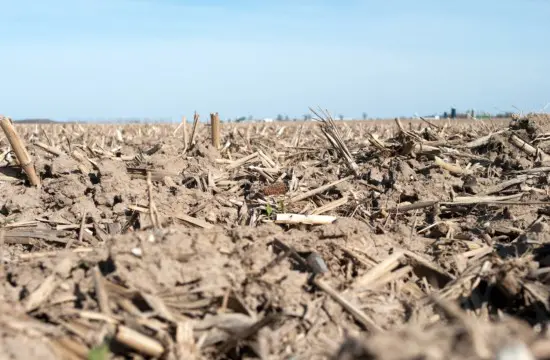Choosing a tillage practice in consideration of yield potential requires an understanding of crop residue and how each cropping sequence changes your field.
Below are considerations for making tillage and cropping sequence decisions:
- Different crops produce different amounts of residue. For example, 130-bushel-per-acre corn provides approximately 7,300 pounds of above-ground residue, whereas a comparable 40-bushel-per-acre soybean crop on that same land would produce less than half that amount (3,600 pounds). Crops vary in chemical makeup, which determines their rate of decomposition and their effect on the soil’s physical properties and nutrient availability. For example, heavy cornstalk residues will increase water intake and reduce evaporation. If you choose to leave residue in the field, watch for any potential evidence of plant disease or residue toxicity.
- Crop residues and placement influence soil water content, drainage and aeration. Soil water content is higher under a continuous corn cropping sequence than with a corn-soybean rotation, because more residue is produced. In years when moisture is deficient, continuous corn cropping can result in higher yields, but it can markedly reduce yields when excess moisture is a problem. Since farmers do not know the weather for the upcoming growing season, the results of residue on yield are somewhat of a gamble. Placement of residue (whether it is left on or near the surface, partially incorporated with a chisel or disc, or plowed under) also influences decomposition. If you choose to leave large amounts of residue, the soil’s organic matter and its water-holding capacity are likely to increase.
- Soil temperatures will be lower with increased residue. More residue and higher soil moisture levels require more energy to heat water than air. Also, surface residue insulates the ground, slowing the rate of soil warmup. Lower soil temperature can reduce the rate of seed germination and plant growth early in the season, as well as slow microbial activity and yield. The farther north you farm leaving crop residue, the more likely you may see a reduction in yields, especially on poorly drained soils and under cooler temperatures.
- “Soil aggregate” refers to a cluster or mass of soil particles. The higher the level of soil aggregation, the higher the quality of soil structure. Both cropping sequence and tillage system are of major importance to soil structure over the long run and to yield potential. For example, crops like alfalfa produce root channels that extend several feet down, improving drainage and aeration. Annual row crops, such as corn and soybeans, are less effective. If you leave crop residue on the surface or partially incorporated, you can minimize surface sealing and crusting.
- Nutrient availability will usually be higher when there is less residue present or when the residue has a low carbon-to-nitrogen ratio. If you leave residues from higher nitrogen crops, like soybean, in the field, they will decompose rapidly and provide nutrients that are readily available to the next growing crop. High concentrations of surface residues can lower nutrient availability. Be sure to base your nutrient needs and applications accordingly.
- When residue of continuous corn or soybeans is left on the soil surface all year, it is apt to harbor weed seeds, insects and diseases. Serious crop damage can occur if these pests are not adequately controlled. Crop rotation reduces the potential for these problems.
- The amount, type and placement of residue will influence weed species present and how they can best be controlled. Herbicides should be rotated, as well as crops, permitting control of a broader spectrum of weeds than is possible under monoculture. Rotating crops can reduce the potential for serious insect and disease infestations associated with specific crop residues, especially where continuous corn or soybeans are produced under conservation tillage.
Although large amounts of residue can improve the soil’s organic matter and water-holding capacity, soil temperature can also be influenced, especially in naturally cooler climates. If you are considering modifying tillage or cropping sequence decisions, it’s important to look at the whole picture of how crop residue may affect yields and other production factors such as moisture content, soil structure, nutrient availability and pest challenges.

